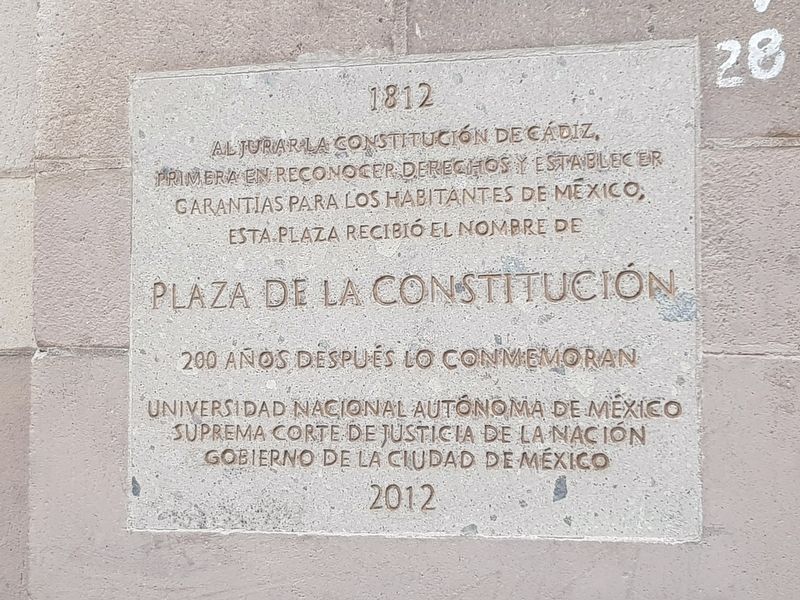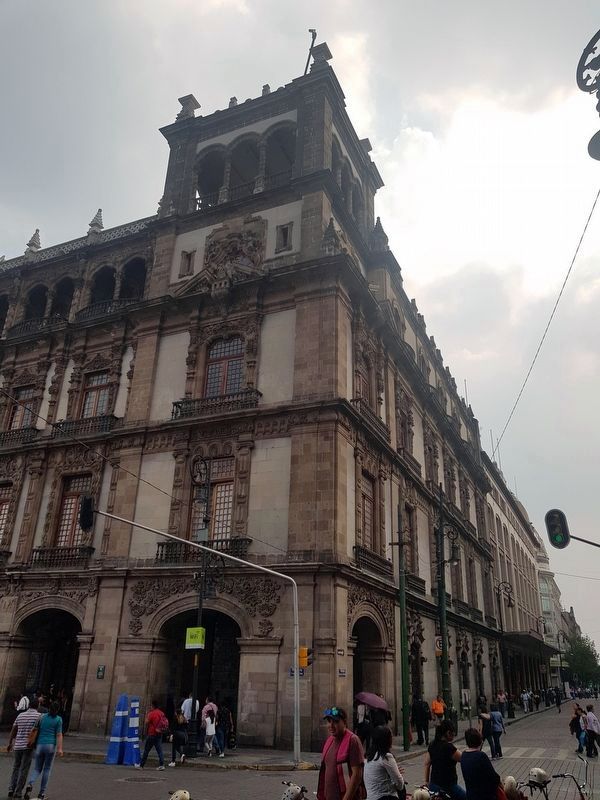Centro Histórico in Ciudad de México, Mexico — The Valley of Mexico (The Central Highlands)
The Constitution of Cádiz
Al jurar la Constitución de Cádiz, primera en reconocer derechos y establecer garantías para los habitantes de México, esta plaza recibió el nombre de Plaza de la Constitución
200 años después lo conmemoran
Universidad Nacional Autónoma de México, Suprema Corte de Justicia de la Nación, Gobierno de la Ciudad de México
2012
1812
Upon ratification of the Constitution of Cádiz, the first to recognize rights and establish guarantees for the inhabitants of Mexico, this square was named Constitution Plaza
200 years later it is commemorated
National Autonomous University of Mexico, Supreme Court of Justice of the Nation, Government of the City of Mexico
2012
Erected 2012 by Universidad Nacional Autónoma de México, Suprema Corte de Justicia de la Nación, Gobierno de la Ciudad de México.
Topics. This historical marker is listed in these topic lists: Colonial Era • Government & Politics. A significant historical year for this entry is 1812.
Location. 19° 25.915′ N, 99° 8.057′ W. Marker is in Ciudad de México. It is in Centro Histórico. Marker is at the intersection of Plaza de la Constitución and Calle 5 de Febrero, on the right when traveling east on Plaza de la Constitución. Touch for map. Marker is in this post office area: Ciudad de México 06000, Mexico. Touch for directions.
Other nearby markers. At least 8 other markers are within walking distance of this marker. Gran Hotel de la Ciudad de México (a few steps from this marker); El Centro Mercantil (within shouting distance of this marker); Las Fábricas Universales (about 90 meters away, measured in a direct line); El Palacio de Hierro (about 90 meters away); The Temple of San Bernardo (about 120 meters away); Diego Franco (about 120 meters away); Salón Peter Gay (about 120 meters away); Café del Cazador (about 120 meters away). Touch for a list and map of all markers in Ciudad de México.
Also see . . . The Spanish Constitution of 1812. The Political Constitution of the Spanish Monarchy (Spanish: Constitución Política de la Monarquía Española), also known as the Constitution of Cádiz (Spanish: Constitución de Cádiz) and as La Pepa, was the first Constitution of Spain and one of the earliest constitutions in world history. It was established on 19 March 1812 by the Cortes of Cádiz, the first Spanish legislature. With the notable exception of proclaiming Roman Catholicism as the official and sole legal religion
in Spain, the constitution was one of the most liberal of its time: it affirmed national sovereignty, separation of powers, freedom of the press, free enterprise, abolished feudalism, and established a constitutional monarchy with a parliamentary system. It was one of the first constitutions that allowed universal male suffrage, through a complex indirect electoral system. It was repealed by King Ferdinand VII in 1814 in Valencia, who re-established absolute monarchy.
The Constitution had many difficulties becoming fully effective: much of Spain was ruled by the French, while the rest of the country was in the hands of interim Junta governments focused on resistance to the Bonapartes rather than on the immediate establishment of a constitutional regime. Many of the overseas territories did not recognize the legitimacy of these interim metropolitan governments, leading to a power vacuum and the establishment of separate juntas on the American continent. On 24 March 1814, six weeks after returning to Spain, Ferdinand VII abolished the constitution and had all monuments to it torn down. Only the Constitution Obelisk in Saint Augustine, Florida survived. The constitution was reinstated during the Trienio Liberal (1820–1823), and again briefly 1836—1837 while the Progressives prepared the Constitution of 1837. Adapted from Wikipedia (Submitted on October 23, 2018, by J. Makali Bruton of Accra, Ghana.)
Credits. This page was last revised on April 17, 2020. It was originally submitted on October 23, 2018, by J. Makali Bruton of Accra, Ghana. This page has been viewed 121 times since then and 15 times this year. Photos: 1, 2. submitted on October 23, 2018, by J. Makali Bruton of Accra, Ghana.

